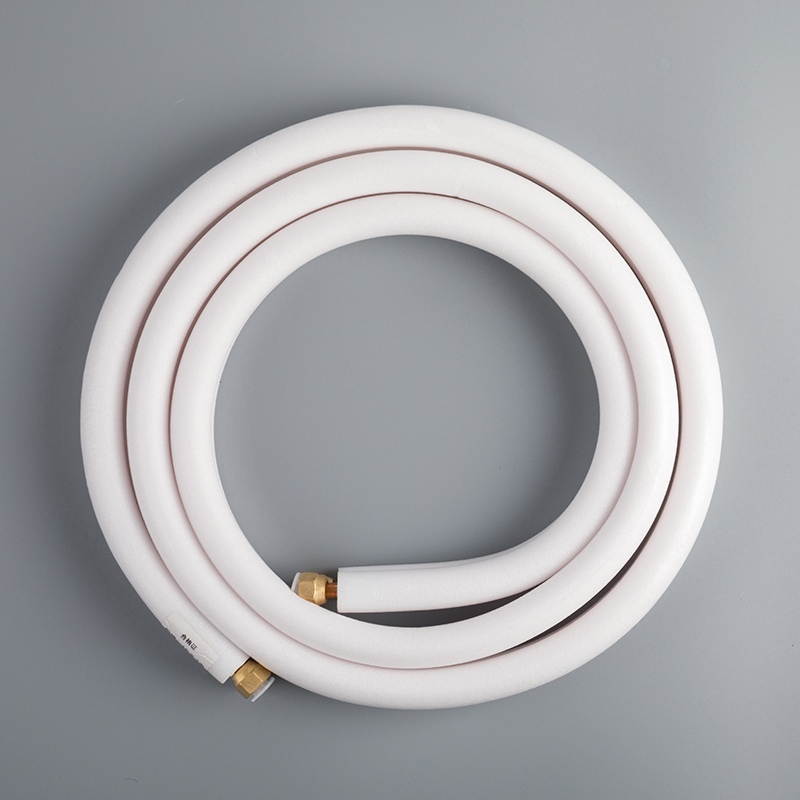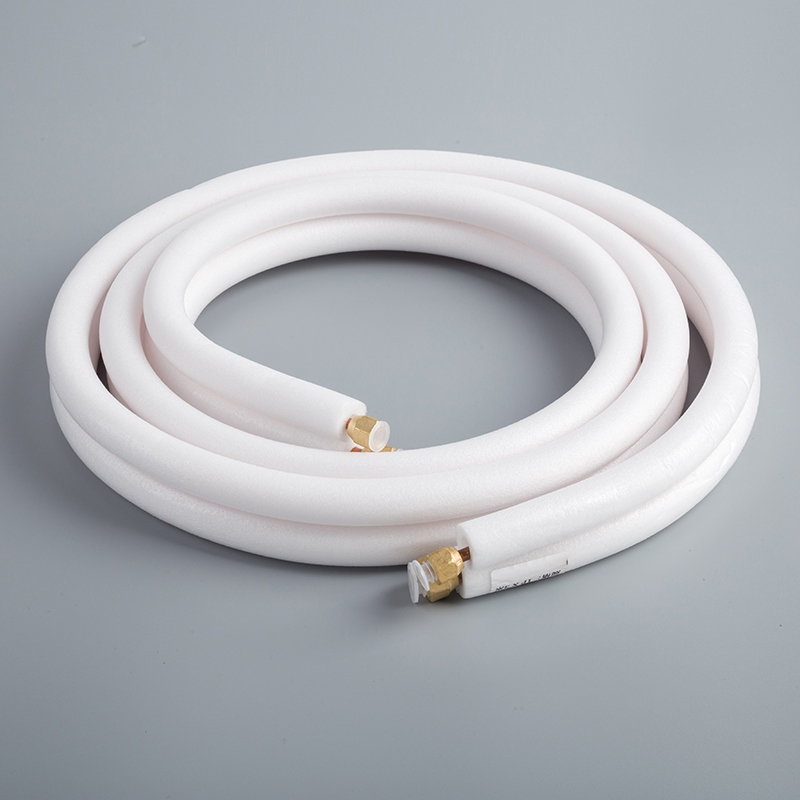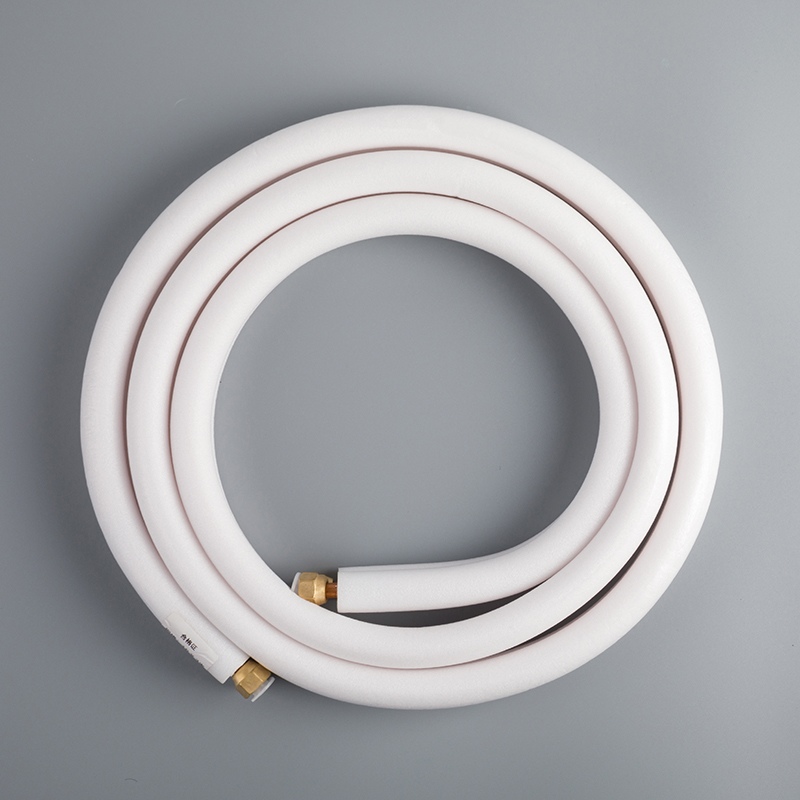Understanding the Types of Copper Pipes for Air Conditioning

Copper pipes play a vital role in air conditioning systems by ensuring efficient refrigerant flow and reliable performance. Their high thermal conductivity allows for faster heat transfer, which improves energy efficiency and reduces operating costs. Unlike materials like plastic, copper resists corrosion effectively, making it less prone to leaks or cracks. Its malleability also simplifies installation, even in complex HVAC setups. These qualities make copper the preferred choice for maintaining optimal air conditioning performance. When deciding what type of copper pipe is used for air conditioning, understanding these benefits helps you make an informed decision.
Key Takeaways
Copper pipes are important for air conditioners. They help refrigerants flow well and save energy.
Type K copper pipes are the strongest. They work best for high-pressure systems like heavy-duty HVAC setups.
Type L copper pipes are strong and cost less. They are good for homes and small businesses.
Type M copper pipes are light and cheap. They are great for low-pressure home systems but not for outdoor use.
Checking and cleaning pipes often helps them last longer and keeps air conditioners working well.
Types of Copper Pipes for Air Conditioning

Type K Copper Pipes
Characteristics of Type K
Type K copper pipes are known for their exceptional durability and strength. Their thick walls make them highly resistant to damage and corrosion, even in harsh environments. These pipes can handle high-pressure applications, making them ideal for demanding air conditioning systems. You can find Type K pipes in both rigid and flexible forms, offering versatility for various installations.
Feature | Description |
|---|---|
Durability | The thick walls of Type K copper pipe make it extremely durable and long-lasting. |
High Pressure | It can withstand higher pressure levels, making it ideal for applications requiring robust performance. |
Corrosion Resistance | Excellent resistance to corrosion ensures a long lifespan, even in harsh environments. |
Common Uses in Air Conditioning
Type K copper pipes are commonly used in HVAC systems, particularly in high-pressure refrigerant lines. Their robust construction makes them suitable for water distribution and fire protection systems as well. If you need a reliable option for demanding air conditioning setups, Type K is an excellent choice.
Type L Copper Pipes
Characteristics of Type L
Type L copper pipes strike a balance between durability and cost-effectiveness. They feature medium-thick walls, which provide better pressure resistance than Type M pipes. This makes them suitable for applications requiring moderate strength. Type L copper tubing is versatile and works well for both residential and commercial air conditioning systems.
Common Uses in Air Conditioning
You’ll often find Type L copper pipes in refrigerant lines for residential and light commercial air conditioning systems. Their moderate thickness makes them easier to install while still offering good durability. These pipes are also used for hot and cold water supply lines, adding to their versatility.
Type M Copper Pipes
Characteristics of Type M
Type M copper pipes are the most affordable option among the different types of copper pipes. Their thinner walls make them lightweight and easy to handle, which simplifies installation. However, they are best suited for low-pressure applications due to their reduced strength.
Common Uses in Air Conditioning
Type M copper pipes are ideal for residential air conditioning systems where pressure requirements are lower. Their affordability makes them a popular choice for budget-conscious projects. However, they are not recommended for outdoor or underground installations due to their limited durability.
Capillary Tubes
Characteristics of Capillary Tubes
Capillary tubes are small-diameter copper tubes with a fixed length. They lack moving parts, which makes them simple yet effective components in refrigeration systems. These tubes connect the condenser outlet to the evaporator inlet, allowing liquid refrigerant to flow while controlling its rate. Their design relies on pressure differences between the high and low sides of the system to meter refrigerant flow. Proper sizing and refrigerant charge are essential for their performance.
Key features of capillary tubes include:
Fixed length and small diameter.
Absence of moving parts.
Dependence on pressure differences for refrigerant flow.
Common Uses in Air Conditioning
Capillary tubes are widely used in smaller air conditioning and refrigeration systems. They regulate refrigerant flow efficiently, ensuring system balance and preventing issues like low suction pressure or compressor flooding. These tubes are particularly effective in systems with consistent load conditions. However, their performance depends on proper alignment with the compressor's capacity and the system's overall design.
Refrigeration Copper (ACR)
Characteristics of Refrigeration Copper
Refrigeration copper tubing is specifically manufactured to meet the stringent cleanliness standards required for refrigeration systems. Unlike standard plumbing copper, it undergoes a cleaning and sealing process to eliminate contaminants such as moisture, oil, and particulate matter. This ensures optimal performance and prevents blockages or inefficiencies. During production, nitrogen is used to seal the tubing, preventing oxidation and maintaining long-term system reliability.
Common Uses in Air Conditioning
Refrigeration copper tubing is essential for transporting refrigerant gases between components in HVAC systems. It is commonly used in refrigeration units, walk-in coolers, and industrial machinery to maintain proper temperatures and prevent overheating. In healthcare, it plays a critical role in refrigeration systems for pharmaceuticals. Its durability and cleanliness make it a preferred choice for various applications requiring high performance and reliability.
Applications of Copper Pipes in Air Conditioning Systems

Refrigerant Flow
Role of copper pipes in refrigerant transport
Copper tubes play a critical role in transporting refrigerants within air conditioning systems. Their high durability allows them to withstand the extreme pressures and temperatures associated with refrigerant flow. Copper's adaptability makes it suitable for various HVAC applications, including flexible refrigerant lines. Additionally, its corrosion resistance ensures that refrigerant leaks are minimized, maintaining system efficiency over time.
Key benefits of copper tubes for refrigerant transport include:
High pressure and temperature resistance.
Corrosion resistance for long-term reliability.
Importance of pipe type for refrigerant compatibility
Choosing the right type of copper pipe is essential for refrigerant compatibility. Even a small amount of moisture in the refrigerant can reduce system efficiency significantly. Refrigeration copper tubing undergoes a cleaning process to remove contaminants, ensuring optimal performance. This cleanliness prevents blockages and reduces the risk of system failures.
Did you know? Moisture and contamination in copper tubes account for nearly 30% of HVAC system failures. Selecting the correct pipe type helps avoid these issues and ensures smooth operation.
Heat Exchange
How copper pipes facilitate heat transfer
Copper's exceptional thermal conductivity makes it ideal for heat exchange in air conditioning systems. It transfers heat efficiently, allowing the refrigerant to cool or heat the air quickly. This property is especially beneficial in air-to-air and air-to-refrigerant heat exchangers, where rapid temperature changes are required.
Why copper is preferred for thermal conductivity
Copper outperforms other materials like aluminum and stainless steel in thermal conductivity. Its ability to conduct heat is approximately 20 times greater than stainless steel and twice that of aluminum. This efficiency reduces energy consumption and enhances the overall performance of air conditioning systems. Furthermore, copper's resistance to corrosion ensures that its thermal properties remain intact over time.
System Durability
Impact of pipe type on system longevity
The type of copper pipe you choose directly affects the durability of your air conditioning system. For example:
Type K Copper Pipe: Thick walls provide exceptional durability and high-pressure resistance.
Type L Copper Pipe: Moderate thickness balances durability and cost, making it versatile for most systems.
Type M Copper Pipe: Thinner walls make it less durable but suitable for low-pressure applications.
Selecting the appropriate pipe type ensures your system lasts longer and performs reliably.
Resistance to corrosion and wear
Copper's natural corrosion resistance is a significant advantage. A protective oxide layer forms on its surface, shielding it from rust and wear. This property reduces the need for frequent repairs and replacements, saving you time and money.
Corrosion resistance is one of the reasons copper pipes are preferred for air conditioning. Unlike other materials, copper does not rust easily, even when exposed to moisture. This durability ensures fewer interruptions and a longer system lifespan.
Factors to Consider When Choosing Copper Pipes
Durability and Strength
How pipe thickness affects durability
The thickness of copper tubes directly impacts their durability. Thicker walls, like those in Type K and Type L pipes, provide greater resistance to pressure and wear. This makes them suitable for high-pressure air conditioning systems. On the other hand, thinner walls, such as those in Type M pipes, are less durable but work well for low-pressure applications. Choosing the right thickness ensures your system operates efficiently and lasts longer.
Environmental factors to consider
Environmental conditions play a significant role in selecting copper pipes. For example, pipes exposed to moisture or chemicals require high corrosion resistance to prevent leaks and maintain longevity. Copper's natural resistance to corrosion makes it ideal for air conditioning systems. Additionally, high thermal conductivity ensures efficient heat transfer, which enhances energy efficiency.
Factor | Description |
|---|---|
Quality Standards | Should meet national standards and industry specifications. |
Corrosion Resistance | Essential to prevent leaks and ensure longevity of the pipes. |
Thermal Conductivity | High thermal conductivity is necessary for energy efficiency in air systems. |
Specifications | Diameter and wall thickness should match the air conditioning system needs. |
Cost and Budget
Price differences between pipe types
The cost of copper tubes varies based on their type and wall thickness. For instance:
Type | Wall Thickness (inches) | Application |
|---|---|---|
Type K | 0.049 | Water distribution |
Type L | 0.040 | Water distribution |
Type M | 0.028 | Water distribution |
Refrigeration | Varies | Refrigerant systems (high pressure) |
Thicker pipes like Type K are more expensive due to their durability, while thinner options like Type M are more affordable but less robust. Refrigeration copper tubing, designed for specific HVAC needs, often falls in the mid-to-high price range.
Balancing cost with performance
Balancing cost and performance requires careful consideration. While thicker pipes may have a higher upfront cost, their durability and efficiency can reduce maintenance expenses over time. Selecting pipes with the appropriate diameter and wall thickness ensures efficient operation, leading to long-term savings. Opting for well-known brands can also provide reliable products and better after-sales service.
Refrigerant Compatibility
Matching pipe type with refrigerant type
Refrigerant compatibility is crucial for maintaining system efficiency. Refrigeration copper tubing undergoes a cleaning process to remove contaminants, ensuring it works seamlessly with refrigerants like R-410A. Using incompatible pipes can lead to moisture buildup, which reacts with refrigerants and forms corrosive acids. This can damage the system and reduce its lifespan.
Avoiding leaks and inefficiencies
Moisture control is essential when selecting copper tubes for air conditioning systems. Even a small amount of trapped water can degrade refrigerant properties and reduce efficiency by up to 5%. Choosing the right type of refrigeration copper tubing minimizes these risks, ensuring smooth operation and preventing costly repairs.
Installation Requirements
Ease of installation for different pipe types
When installing copper pipes for air conditioning, you should consider the unique challenges of each type. Some pipes are easier to handle, while others require more effort due to their thickness or application.
Type M pipes are lightweight and have thinner walls, making them easier to cut and fit. However, their reduced durability means you must monitor water pressure and chemical composition during installation. These pipes are unsuitable for outdoor or underground use, unlike Type L pipes.
Type L pipes offer a balance between ease of installation and durability. Their medium-thick walls make them versatile for most residential and commercial setups.
Type K pipes are the most durable but can be challenging to install due to their thick walls. You may need specialized tools to bend or cut these pipes effectively.
Improper installation can lead to issues like corrosion. Factors such as water chemistry, high flow rates, and poor electrical grounding can damage the pipes over time. Ensuring proper installation techniques minimizes these risks and extends the lifespan of your system.
Tools and techniques needed for proper installation
Installing copper pipes requires preparation and the right tools. Start by inspecting the installation environment to ensure there is enough space for unobstructed work. Check the pipes for defects before beginning.
Here’s a step-by-step guide to help you:
Measure the required length of the copper pipe.
Use a pipe cutter to cut the pipe to size.
Deburr the edges to remove sharp or uneven surfaces.
Dry-fit the pipes and fittings to check alignment.
Clean the ends and apply flux to prepare for soldering.
Solder the joints using a propane torch.
Test for leaks after soldering.
Insulate the pipes if necessary.
Perform a final inspection to ensure all connections are secure.
You’ll also need tools like a pipe bender, flaring tool, and propane torch. Properly cutting and bending the pipes ensures a precise fit, while soldering or flaring creates strong, leak-proof connections. Following these steps guarantees a smooth installation process and reliable system performance.
Maintenance and Longevity of Copper Pipes
Regular Inspection
Identifying signs of wear and tear
Regular inspections help you detect early signs of damage in copper pipes. Look for discoloration, green stains, or pitting, as these indicate corrosion. Reduced water pressure may signal mineral buildup inside the pipes. Pinhole leaks, though small, can cause significant issues if left unaddressed.
Steps to inspect copper pipes effectively:
Examine the pipes for visible corrosion, leaks, or damage.
Check for discoloration or green stains, which often point to corrosion.
Address leaks immediately to avoid costly repairs.
Preventing leaks and blockages
Frequent inspections prevent leaks and blockages by identifying potential problems early. Corrosion, if ignored, can lead to cracks or leaks. Blockages caused by mineral deposits reduce system efficiency. Addressing these issues promptly ensures your air conditioning system operates smoothly.
Cleaning and Care
Best practices for cleaning copper pipes
Cleaning copper pipes regularly maintains their efficiency. Use a special copper pipe cleaner or mild detergent. Apply the cleaner to the pipe's surface and gently wipe it with a soft cloth to remove dust, oil, and impurities. Avoid abrasive tools, as they can scratch the pipes and compromise their durability.
Avoiding damage during maintenance
Handle copper pipes carefully during maintenance to prevent damage. Use appropriate tools and techniques to avoid bending or denting the pipes. Regular cleaning and proper care extend the lifespan of your air conditioning system.
Replacement Guidelines
When to replace copper pipes
Replace copper pipes when you notice severe corrosion, persistent leaks, or reduced performance. Pipes with visible defects or those that fail to meet quality standards should also be replaced. Timely replacement prevents further damage to your air conditioning system.
Choosing the right replacement type
When selecting replacement pipes, consider factors like corrosion resistance, thermal conductivity, and durability. Choose pipes that meet national standards and match your system's cooling capacity. High-quality copper pipes ensure efficient heat transfer and long-term reliability.
Copper pipes play a crucial role in ensuring your air conditioning system operates efficiently. Each type of copper pipe offers unique benefits, from durability to cost-effectiveness. By understanding their characteristics and applications, you can select the best option for your system. Factors like refrigerant compatibility and installation requirements also influence performance. Regular maintenance, such as cleaning and inspections, helps extend the lifespan of your pipes. With proper care, you can enjoy reliable air conditioning performance for years to come.
FAQ
What is the best type of copper pipe for residential air conditioning systems?
Type L copper pipes are the best choice for residential systems. They offer a balance of durability and cost-effectiveness. Their medium-thick walls handle moderate pressure, making them reliable for most home air conditioning setups.
Can you use Type M copper pipes for outdoor installations?
No, Type M pipes are not suitable for outdoor use. Their thinner walls make them less durable and prone to damage. For outdoor installations, choose Type K or Type L pipes for better strength and corrosion resistance.
How do you prevent copper pipes from corroding?
To prevent corrosion, ensure proper installation and avoid exposing pipes to harsh chemicals or moisture. Regular cleaning and inspections help maintain their condition. Using insulation can also protect pipes from environmental factors.
Are capillary tubes reusable in air conditioning systems?
No, capillary tubes are not reusable. Their fixed length and small diameter make them specific to the system's design. Replacing them ensures proper refrigerant flow and system efficiency.
Why is refrigeration copper tubing sealed with nitrogen?
Refrigeration copper tubing is sealed with nitrogen to prevent oxidation during storage. This process keeps the interior clean and free from contaminants, ensuring optimal performance when used in air conditioning systems.
See Also
The Benefits of Using Copper Pipes in AC Systems
Pure Copper Pipes: Essential For Optimal Air Conditioning
Transforming Air Conditioning With Pure Copper Pipes


